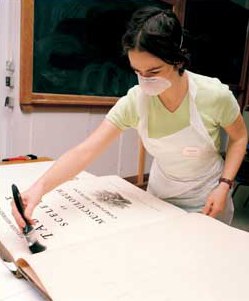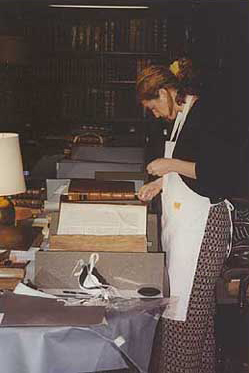Insitu conservation services
The traditional approach to collection conservation tends to be all or nothing: items that are badly damaged are sent for full conservation, whilst the majority of material, with varying amounts of physical wear and structural damage, remain untreated. This results in a number of consequences, which are invariably found in most collections:
- Many collections (particularly books and archives) are unacceptably dirty. Dirt is not only unsightly, but is acidic and causes cellulose decay. Its presence increases dust levels within the storage areas, which are then transferred throughout the collection.
- Collections of bound volumes are allowed to become physically damaged, although not to the extent that they require immediate rebinding. Over periods of time, the backlog of slightly damaged and dirty material increases, and eventually the problem becomes too large to be tackled through traditional workshop-based conservation and rebinding.
- As the levels of damage become worse, the scale of the conservation and binding problem increases. In order to cope with this, cheaper methods of treatment are resorted to, and these add to the long-term problems associated with use and decay. Within book collections, rare and original bindings are replaced rather than restored, the latter option being mistakenly viewed as uneconomical. This is seen increasingly as unethical and contrary to most preservation policies.
 In order to tackle this problem, conservation methods have been developed to clean and repair damaged material on site. Referred to in the past as refurbishment, but now called insitu conservation, this approach is particularly effective when used within library and archive collections. It involves removal of dirt and dust from text blocks and book covers, repair and consolidation of damaged pages, repair and support of broken binding structures, and wrapping and enclosing of the most degraded items, so as to prevent further decay whilst awaiting binding treatment.
In order to tackle this problem, conservation methods have been developed to clean and repair damaged material on site. Referred to in the past as refurbishment, but now called insitu conservation, this approach is particularly effective when used within library and archive collections. It involves removal of dirt and dust from text blocks and book covers, repair and consolidation of damaged pages, repair and support of broken binding structures, and wrapping and enclosing of the most degraded items, so as to prevent further decay whilst awaiting binding treatment.
Insitu conservation reduces transport, packing and insurance costs, and ensures that all items remain accessible. Control of the collections stays with the custodian, who is able to liaise with conservators about treatments, storage, and all other issues that emerge from the ongoing conservation programme.
 We are always surprised at how many dirty, damaged and poorly mounted works of art on paper adorn the walls of large organisations, even where there is a very visible concern for conservation in other areas. Given that framed works of art often represent the public face of institutions, they can create an erroneous impression of the commitment to collection preservation, whilst also reducing the longevity of many valuable pictures. The problem is not usually a lack of intent; rather, the pictures have been exhibited for so long within the same context that they are taken for granted, and are no longer looked at critically by members of staff. However, it is often the one thing that visitors observe, so it is important for them to be clean and carefully mounted in archival quality board.
We are always surprised at how many dirty, damaged and poorly mounted works of art on paper adorn the walls of large organisations, even where there is a very visible concern for conservation in other areas. Given that framed works of art often represent the public face of institutions, they can create an erroneous impression of the commitment to collection preservation, whilst also reducing the longevity of many valuable pictures. The problem is not usually a lack of intent; rather, the pictures have been exhibited for so long within the same context that they are taken for granted, and are no longer looked at critically by members of staff. However, it is often the one thing that visitors observe, so it is important for them to be clean and carefully mounted in archival quality board.
Removing the works of art from their frames in order to remount is a relatively simple process, which can usually be undertaken within the collection. This reduces transport and insurance costs, and ensures that the collections remain accessible. Whilst the pictures are out of their frames, there is also the option of carrying out basic cleaning and repair, much of which can also take place insitu. As part of any programme of remounting and cleaning, Preservation Solutions can also organise professional rehanging of picture collections, in order to rotate stock, and reduce the cumulative effects of external environmental conditions.
"Over the last 10 years, our paper conservation projects have ranged in size from £30 to £30,000. We have found that nothing is too small to matter, or too large to cope with."
